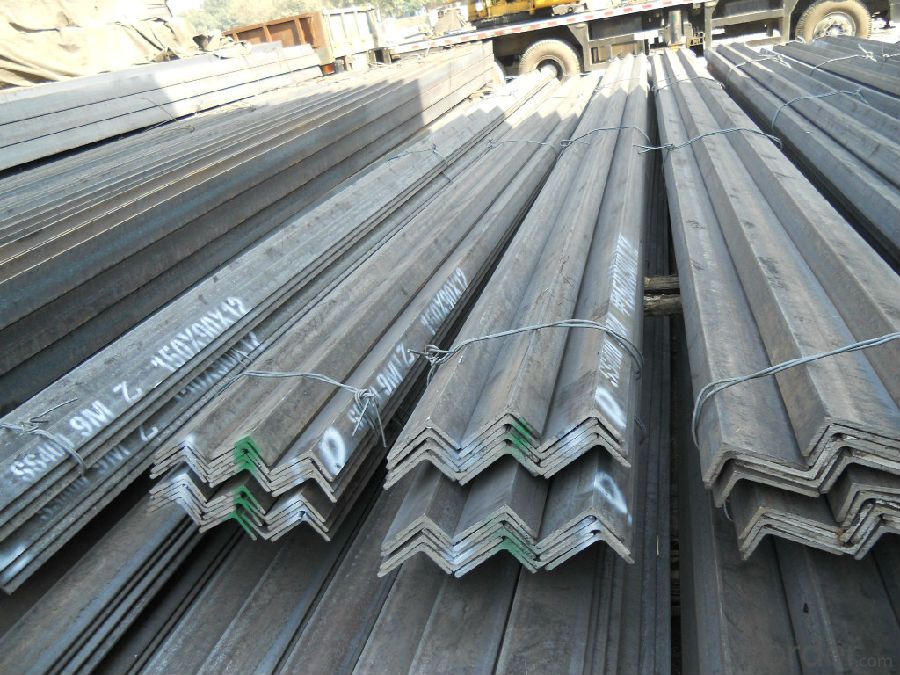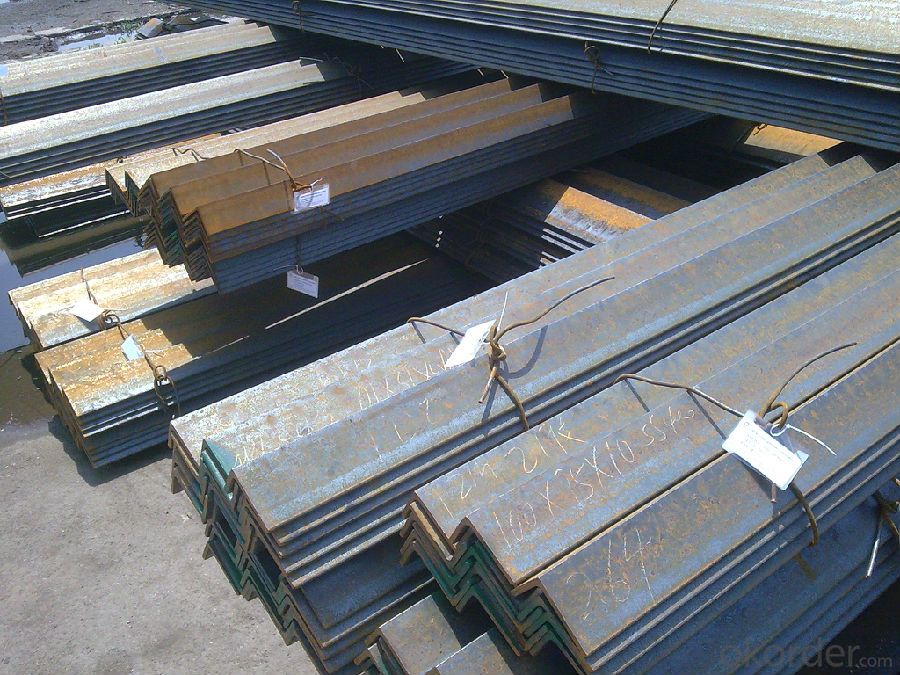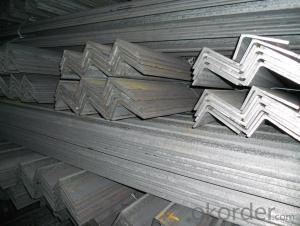Prime HR Unequal Angle Steel For Steel Structure
- Loading Port:
- China main port
- Payment Terms:
- TT OR LC
- Min Order Qty:
- 100 m.t.
- Supply Capability:
- 20000 m.t./month
OKorder Service Pledge
OKorder Financial Service
You Might Also Like
Product Description:
OKorder is offering Prime HR Unequal Angle Steel For Steel Structure at great prices with worldwide shipping. Our supplier is a world-class manufacturer of steel, with our products utilized the world over. OKorder annually supplies products to African, South American and Asian markets. We provide quotations within 24 hours of receiving an inquiry and guarantee competitive prices.
Product Applications:
PrimePrime HR Unequal Angle Steel For Steel Structure are ideal for structural applications and are widely used in the construction of buildings and bridges, and the manufacturing, petrochemical, and transportation industries.
Product Advantages:
OKorder's Prime HR Unequal Angle Steel For Steel Structure are durable, strong, and wide variety of sizes.
Main Product Features:
· Premium quality
· Prompt delivery & seaworthy packing (30 days after receiving deposit)
· Can be recycled and reused
· Mill test certification
· Professional Service
· Competitive pricing
Product Specifications:
Manufacture: Hot rolled
Grade: Q195 – 235
Certificates: ISO, SGS, BV, CIQ
Length: 6m – 12m, as per customer request
Packaging: Export packing, nude packing, bundled
| UNEQUAL ANGLE STEEL | |||||
| size(mm) | a(mm) | a1(mm) | thickness(mm) | kg/m | length(m) |
| 75*50*5 | 75 | 50 | 5 | 4.808 | 6m,9m,12m |
| 75*50*6 | 75 | 50 | 6 | 5.699 | 6m,9m,12m |
| 75*50*8 | 75 | 50 | 8 | 7.431 | 6m,9m,12m |
| 100*75*7 | 100 | 75 | 7 | 9.34 | 6m,9m,12m |
| 100*75*8 | 100 | 75 | 8 | 10.6 | 6m,9m,12m |
| 100*75*9 | 100 | 75 | 9 | 11.8 | 6m,9m,12m |
| 100*75*10 | 100 | 75 | 10 | 13 | 6m,9m,12m |
| 100*75*12 | 100 | 75 | 12 | 15.4 | 6m,9m,12m |
| 125*75*7 | 125 | 75 | 7 | 10.7 | 6m,9m,12m |
| 125*75*8 | 125 | 75 | 8 | 12.2 | 6m,9m,12m |
| 125*75*9 | 125 | 75 | 9 | 13.6 | 6m,9m,12m |
| 125*75*10 | 125 | 75 | 10 | 15 | 6m,9m,12m |
| 125*75*12 | 125 | 75 | 12 | 17.8 | 6m,9m,12m |
| 150*90*8 | 150 | 90 | 8 | 14.7 | 6m,9m,12m |
| 150*90*9 | 150 | 90 | 9 | 16.4 | 6m,9m,12m |
| 150*90*10 | 150 | 90 | 10 | 18.2 | 6m,9m,12m |
| 150*90*12 | 150 | 90 | 12 | 21.6 | 6m,9m,12m |
| 200*100*10 | 200 | 100 | 10 | 23 | 6m,9m,12m |
| 200*100*12 | 200 | 100 | 12 | 27.62 | 6m,9m,12m |
| 200*100*15 | 200 | 100 | 15 | 34.04 | 6m,9m,12m |
FAQ:
Q1: Why buy Materials & Equipment from OKorder.com?
A1: All products offered byOKorder.com are carefully selected from China's most reliable manufacturing enterprises. Through its ISO certifications, OKorder.com adheres to the highest standards and a commitment to supply chain safety and customer satisfaction.
Q2: How soon can we receive the product after purchase?
A2: Within three days of placing an order, we will arrange production. The normal sizes with the normal grade can be produced within one month. The specific shipping date is dependent upon international and government factors, the delivery to international main port about 45-60days.
Q3: How many tons of steel products could be loaded in containers?
A3: Usually the steel products are delivered by bulk vessel because of the large quantity and the freight. However, there are no bulk vessel enter some seaports so that we have to deliver the cargo by containers. The 6m steel product can be loaded in 20FT container, but the quantity is changed according to the size, usually from 18tons to 25tons.
Images:


- Q:What are the standard lengths for steel angles?
- The standard lengths for steel angles can vary depending on the manufacturer and specific requirements, but common lengths range from 20 feet to 40 feet.
- Q:What is the maximum length for a steel angle bracket?
- The maximum length for a steel angle bracket can vary depending on the specific design and manufacturer, but it generally ranges from 6 to 12 inches.
- Q:How do steel angles contribute to the sustainability of a city?
- Steel angles contribute to the sustainability of a city in several ways. Firstly, steel angles are a crucial component in the construction industry, used in the fabrication of buildings, bridges, and other infrastructure. Steel is known for its strength, durability, and resistance to external factors such as corrosion and fire. By using steel angles in construction projects, cities can ensure the longevity and safety of their structures, reducing the need for frequent maintenance or replacement. This leads to a significant reduction in the consumption of resources over time, making cities more sustainable. Additionally, steel angles offer design flexibility, allowing architects and engineers to create innovative and efficient structures. Their versatility enables the construction of sustainable buildings that incorporate features such as energy-efficient designs, natural lighting, and effective insulation. By utilizing steel angles in the construction process, cities can promote sustainable practices and reduce energy consumption, contributing to a more sustainable urban environment. Furthermore, steel is a highly recyclable material, with a recycling rate of around 90%. By using steel angles in construction, cities can contribute to a circular economy by promoting the recycling and reuse of steel products. This reduces the demand for raw materials and minimizes waste, thereby reducing the environmental impact of construction projects. The use of recycled steel also helps to conserve energy and reduce greenhouse gas emissions associated with the production of new steel. In conclusion, steel angles play a vital role in the sustainability of a city by providing durable and long-lasting structures, enabling energy-efficient designs, and promoting the recycling and reuse of materials. By incorporating steel angles in construction projects, cities can create sustainable infrastructure that contributes to the overall well-being of the environment and the community.
- Q:Are steel angles suitable for outdoor furniture?
- Steel angles are indeed appropriate for outdoor furniture. Steel is known for its durability and strength, enabling it to endure diverse weather conditions. This quality makes it an exceptional selection for outdoor furniture. Steel angles contribute to stability and structural support, guaranteeing that the furniture can bear heavy loads and remain firm. Furthermore, when properly treated, steel is resistant to rust and corrosion, which is crucial for outdoor furniture exposed to moisture and changing weather. In addition, steel angles offer a sleek and contemporary aesthetic, enabling versatile design possibilities for outdoor furniture. In summary, the durability, strength, and resistance to environmental elements make steel angles a dependable and long-lasting option for outdoor furniture.
- Q:Can steel angles be used in load-bearing columns?
- Yes, steel angles can be used in load-bearing columns. Steel angles are commonly used in construction as structural members to provide stability and support for vertical loads. They are able to handle high compressive forces and are often used to reinforce and strengthen load-bearing columns in buildings and other structures.
- Q:Are steel angles prone to rust or corrosion?
- Yes, steel angles are prone to rust or corrosion as they are typically made of carbon steel, which is susceptible to rusting when exposed to moisture and oxygen.
- Q:What is the maximum allowable torsional lateral-torsional buckling stress for a steel angle?
- The maximum allowable torsional lateral-torsional buckling stress for a steel angle depends on various factors such as the type of steel, its dimensions, and the applicable design codes or standards. Without specific details, it is not possible to provide an accurate numerical value for the maximum allowable stress.
- Q:What are the different types of steel angles used in storage tank construction?
- There are several different types of steel angles that are commonly used in storage tank construction. These angles play a crucial role in providing structural support and stability to the tanks. 1. L-angles: L-angles, also known as unequal angles, are widely used in storage tank construction. They have one longer side and one shorter side, forming an L-shape. L-angles are commonly used for tank stiffeners, which help to prevent deformation and maintain the structural integrity of the tank. 2. T-angles: T-angles, also known as tee angles, are another type of steel angle used in storage tank construction. They have a T-shape, with one long side and one shorter side perpendicular to each other. T-angles are often used as horizontal and vertical bracing members in tank structures, providing additional strength and stability. 3. Equal angles: Equal angles, also known as right angles, have two equal sides forming a 90-degree angle. They are commonly used in tank construction for various applications, such as supporting tank roofs, providing reinforcement at the corners, or connecting tank components together. 4. Bulb angles: Bulb angles, also known as bulb flats, have a unique shape with a flat surface and a bulbous section at one end. These angles are often used for tank support structures, such as the tank bottom, to distribute the load evenly and minimize stress concentrations. 5. Rolled steel sections: In addition to the various types of angles mentioned above, rolled steel sections like I-beams, channels, and H-beams are also used in storage tank construction. These sections provide additional strength and support to the tank structure, particularly for larger tanks or in areas with high load requirements. Overall, the choice of steel angles in storage tank construction depends on the specific design requirements, load considerations, and structural integrity needs. It is essential to select the appropriate type and size of angles to ensure the tanks can withstand the anticipated loads and environmental conditions.
- Q:What are the different surface finishes available for painted steel angles?
- Painted steel angles offer a range of surface finishes to meet aesthetic and functional needs. 1. Achieving a smooth finish involves evenly applying a coat of paint and then curing it for durability. 2. Textured finishes create a rougher surface with patterns or textures, achieved through techniques like sandblasting or textured paint. These finishes enhance grip and reduce slipperiness in applications requiring traction. 3. Matte finishes have low sheen or gloss levels, resulting in non-reflective surfaces. This option is ideal for applications desiring a subdued appearance. 4. On the other hand, glossy finishes have high sheen or gloss levels, creating reflective and shiny surfaces. They provide a polished and visually appealing look to painted steel angles. 5. Powder-coated finishes are popular for their durability. This method involves coating the steel angle with a dry powder, which is then cured under heat to form a protective layer. Powder-coated finishes offer excellent resistance to scratches, chemicals, and UV rays. 6. Galvanized finishes involve applying a layer of zinc to the steel surface, providing corrosion resistance. While typically not painted, galvanized steel angles can be painted over if desired, allowing for various color options. In summary, painted steel angles offer a variety of finishes including smooth, textured, matte, glossy, powder-coated, and galvanized. The choice depends on the intended use, desired appearance, and required durability for the application.
- Q:Can steel angles be used in curtain wall or facade systems?
- Yes, steel angles can be used in curtain wall or facade systems. Steel angles are commonly used as structural components in these systems to provide support, stability, and attachment points. They can be used to create framework, support cladding materials, and connect various elements of the curtain wall or facade system together. Additionally, steel angles offer excellent strength and durability, making them suitable for withstanding the loads and forces experienced in these applications.
1. Manufacturer Overview |
|
|---|---|
| Location | |
| Year Established | |
| Annual Output Value | |
| Main Markets | |
| Company Certifications | |
2. Manufacturer Certificates |
|
|---|---|
| a) Certification Name | |
| Range | |
| Reference | |
| Validity Period | |
3. Manufacturer Capability |
|
|---|---|
| a)Trade Capacity | |
| Nearest Port | |
| Export Percentage | |
| No.of Employees in Trade Department | |
| Language Spoken: | |
| b)Factory Information | |
| Factory Size: | |
| No. of Production Lines | |
| Contract Manufacturing | |
| Product Price Range | |
Send your message to us
Prime HR Unequal Angle Steel For Steel Structure
- Loading Port:
- China main port
- Payment Terms:
- TT OR LC
- Min Order Qty:
- 100 m.t.
- Supply Capability:
- 20000 m.t./month
OKorder Service Pledge
OKorder Financial Service
Similar products
New products
Hot products
Related keywords



























